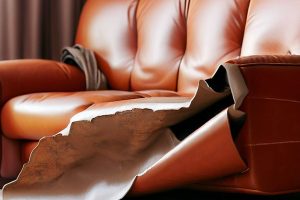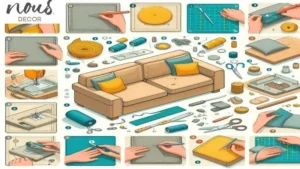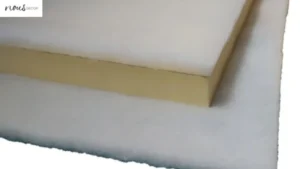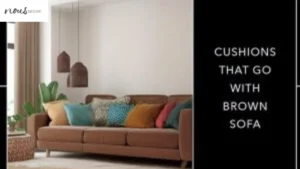Upholsteries are a great way to protect your furniture from spills, stains, and pet hair. However, keeping them in place can be a challenge, especially if you have a rambunctious dog or a leather sofa that’s prone to slip and slide. In this in-depth guide, we’ll explore various methods and products to keep your sofa sofa cover from slippage, so you can enjoy neatly covered and protected furniture in your living room.
From tuck grips to slipcover tucks, we’ll cover ideas to prevent your covers from shifting and bunching up. We’ll also discuss the best practices for using furniture protectors and how to secure them effectively. Whether you have a cozy sectional, a classic loveseat, or a chic sofa, this guide will help you maintain a tidy and stylish look for your furniture while keeping it well-protected from everyday wear and tear.
In this guide, NOUSDECOR will provide you with a couple of methods on “How To Keep Sofa Covers In Place”. So, let’s dive in and discover the secrets to maintaining a perfectly styled living room with secure upholstery to protect your sofa.
Takeaways
- Maintaining Sofa Cover Stability is a crucial aspect of preserving the aesthetic appeal of furniture, and individuals often seek effective solutions for How To Keep Sofa Covers In Place.
- One fundamental approach involves a thorough understanding of Cover Fabrics and strategically Selecting Non-Slip Materials to ensure enduring Sofa Cover Stability.
- Equally important are the Proper Tucking Techniques employed during application, emphasizing the significance of Mastering Tuck-and-Fold Methods for securely Securing Sofa Covers.
- Enhancing Sofa Cover Stability can be achieved through the incorporation of Anti-Slip Accessories, such as Incorporating Gripping Pads and Straps to prevent any unwanted shifts.
- To sustain this stability in the long term, it’s essential to adopt Regular Maintenance Practices, such as Checking and Adjusting Periodically to maintain a snug fit and ensure Long-Term Sofa Cover Stability.
- Exploring Customized Cover Solutions adds a personalized touch, tailoring covers to the specific shape of the furniture, contributing to Personalized Sofa Cover Stability.
- Seasonal considerations, like Adapting Covers for Climate Changes, round out the strategies for Year-Round Sofa Cover Stability.
- In this way, this approach ensures a comprehensive guide to keeping sofa covers securely in place.
How To Keep Sofa Covers In Place – 4 Methods for Keep Your Couch Cover in Place and Tucked
If you want to enjoy your couch without constantly readjusting your upholstery that doesn’t stay steady, there are several methods you can try to keep it tucked and neat.
- A strip of high-quality velcro shouldn’t damage your couch, and by attaching one strip of velcro onto the sofa and the other to the cover, you can ensure that the cover aligns and doesn’t shift.
- You can also staple one line of velcro to the couch and the other to the cover to prevent slipping. If there’s excess fabric at the back, using a wooden spoon to smooth out the middle and tuck in any bunched fabric as deep as possible can make it look neat and prevent slipping.
- Straps, inserts, non-slip pads and grips, and upholstery pins are also effective options for keeping couch covers firmly in place. Just be sure to choose the method that tightly secures the cover without damaging the couch, especially if the fabric is thin and prone to slipping.
With these methods, you can keep your upholstery in place and enjoy a tidy living room without the frustration of constantly readjusting them.
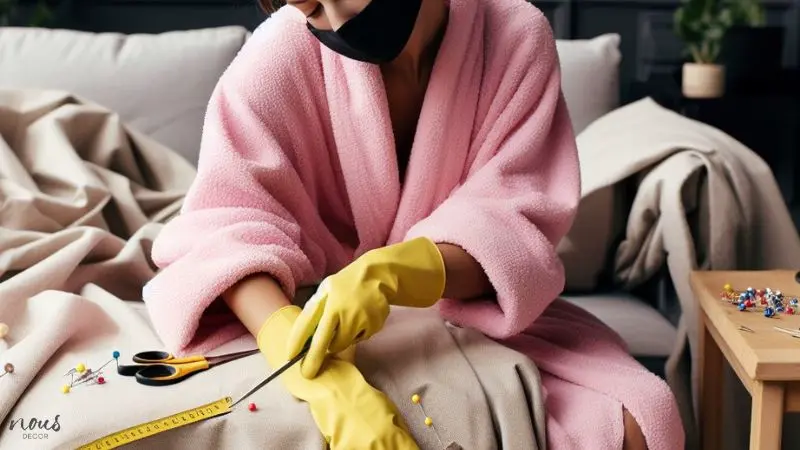
Method 1: Straps
Using straps to keep upholsters in place can be a simple and effective solution to prevent the cover from slippage or moving around. These straps can hold the cover securely in place, allowing you to adjust the couch cover to fit properly and prevent damage to the fabric. Below are the steps to install straps to your furniture cover:
- Put to the upholstery and pull on the material to make a snug fit.
- Push the Extra material on the seat crease between the back and seat cushions.
- Assess your cover’s elastic straps and tie them around the seat legs.
- Tighten the sticks for covers that are drawstring-style.
- If your upholstery does not have straps, then it is possible to make yourself using elastic substances or sew the drawstring right on the material.
By securing the straps to the back of the couch, it creates friction between the couch and the cover, keeping it in place. This not only helps to protect the cover from wear and tear but also provides a neat and polished look to the overall appearance of the couch.
Overall, using straps can be a practical way to keep upholsters in place and maintain a tidy and cohesive look in your living space while still catching up with other latest sofa trends.
Method 2: Inserts
When using inserts to keep upholsters in place, it is important to check the packaging of the inserts to ensure you are using them correctly. By following these steps, you can ensure your seat cover stays in place without shifting or coming loose:
- Dress your seat with the ideal size cover.
- Smoothen the surface with your hands to see if there is extra fabric.
- Push the excess fabric on the split between the couch cushions and the rear.
- Roll up publications or prepare any tube-shaped thing that you can put onto the crack.
- Set the insert to the gap deeply to keep the fabric in place and also to make it feel less noticeable when sitting on the seat.
The inserts will help you keep the upholstries in place as you install them onto the seat, particularly around the base. As you adjust the fabric, keep pressing the inserts down to securely hold the slipcover in place. Furthermore, they will help you keep the slipcover in place as you install it onto the seat, particularly around the base. As you adjust the fabric, keep pressing the inserts down to securely hold the upholstries in place. By following these tips and opening sleeper couch properly, you can enjoy your sofa bed with no worries!
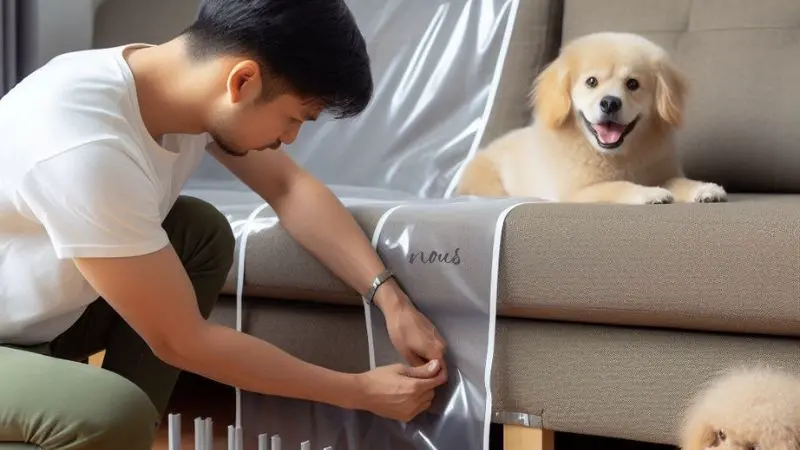
Method 3: Non-slip pads and grips
If you have ever struggled with keeping your upholsters in place, then non-slip pads and grips are the ultimate weapon against couch covers slipping and sliding. These covers offer a simple solution to keep your couch looking neat and tidy and below are the steps to install them so you can finally know how to keep your cover and the couch working together seamlessly.
- Cut a non-slip mat into bits and place them within the seating section of the couch.
- You can use rug grips or non-skid mattress pads and then cut them so for your seat.
- Please put it on the couch cover because you usually would tug the fabric to prevent space between it and the furniture.
- Push the extra material deeply towards the side to tuck in the split between the seat cushions and the framework in the back.
- Smoothen the seat cover again and await slack which may need to be pulled.
These non-slip pads and grips are easy to install, simply place them on the couch and then the cover over the top. The soft surface of the pads provides a barrier to prevent the couch covers from slipping, providing a snug fit and ensuring they stay in place. So learn to master arranging sofa pillows creatively to make your sofa as comfy as possible!
Method 4: Upholstery pins
Using upholstery pins to keep upholsters in place is a simple and cost-effective solution to ensure your furniture looks neat and tidy. By following these steps, you can save money and avoid buying a new sofa while keeping your furniture looking pristine. So get your upholstery pins ready and link sectional sofa pieces together for a comfortable seating experience!
- Install the couch covers set up as you generally would.
- Pull and stretch the cloth to get a snug fit.
- Place in little upholstery hooks on the consequent tight section of the couch cover
- You can use little twist hooks or larger upholstery hooks, depending on the substances.
- Upholstery pins may also be ornamental for extra styling in the surfaces of the sofa cover while at the same time preventing it from slipping.
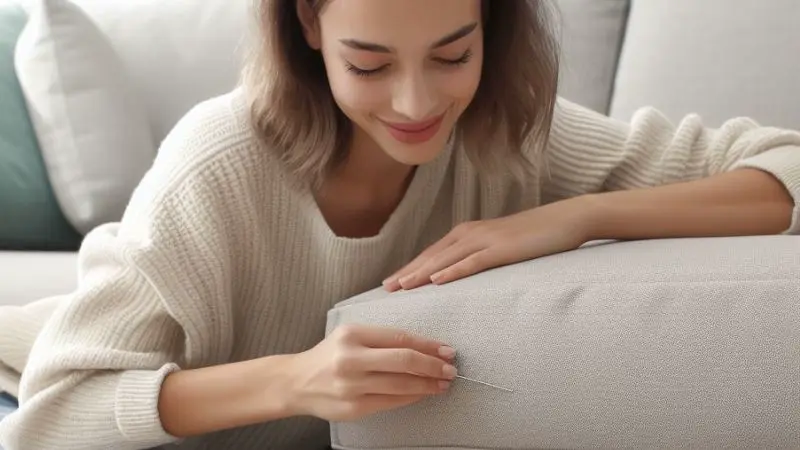
Frequently Asked Questions
Conclusion
In conclusion, there are several effective methods for keeping upholsters in place, whether they are furniture covers, sofa bed furniture slipcovers, or DIY sofa slip covers.
Utilizing slipcover grips, velcro strips, or even a wooden spoon can help secure the covers to the furniture and prevent them from slipping or shifting. Additionally, old magazines can be repurposed to tie them into a tube and place them between the cushions to hold the slipcovers in place. Bunched fabric can be put at strategic points or using tie straps can also help keep the covers secure. It’s important to regularly adjust and reposition the covers to ensure they stay in place.
By implementing these techniques, you can maintain a clean and tidy living space while also preserving the integrity of your furniture. Ultimately, finding the right method that works for your specific furniture and covers is key to achieving a snug and tailored look so that your cover can help improve the look of your furniture without worry.



